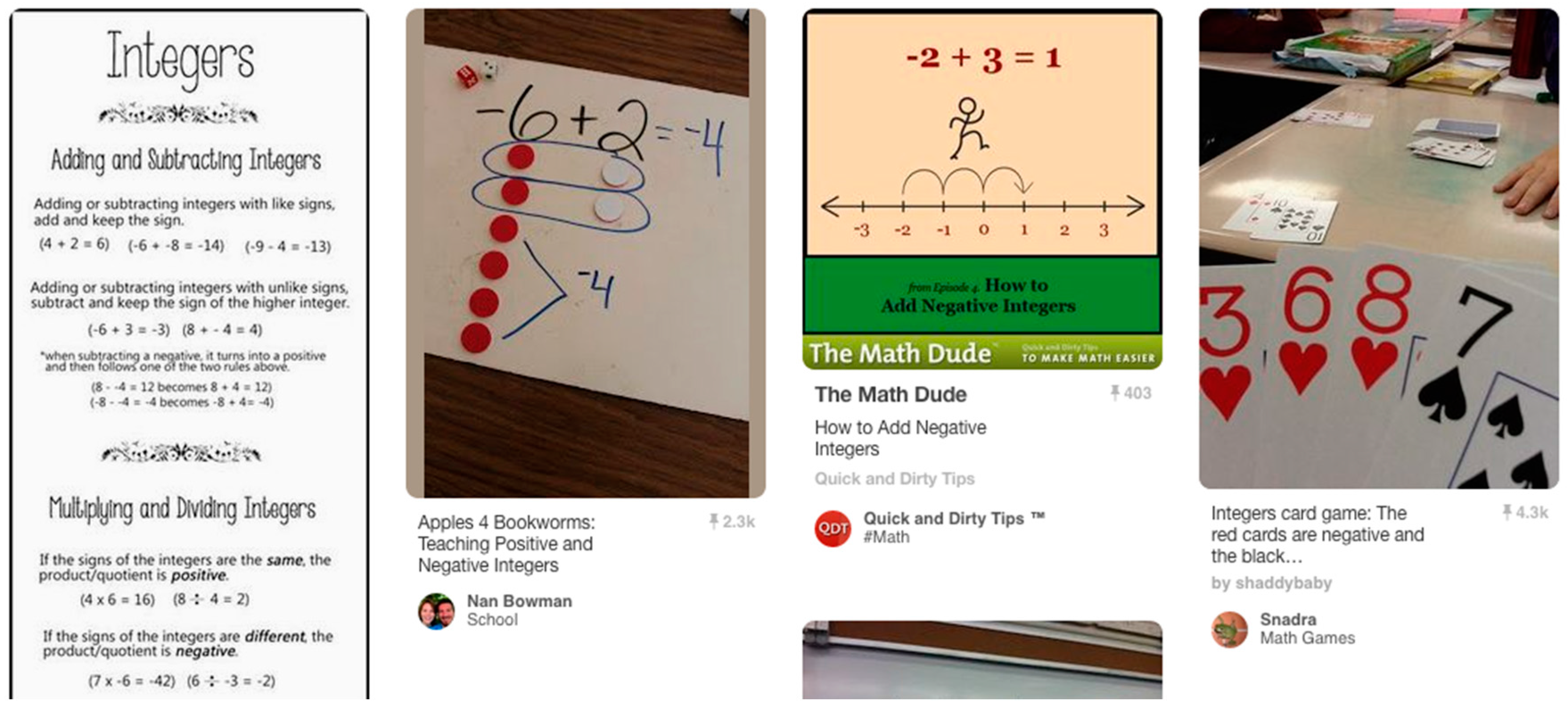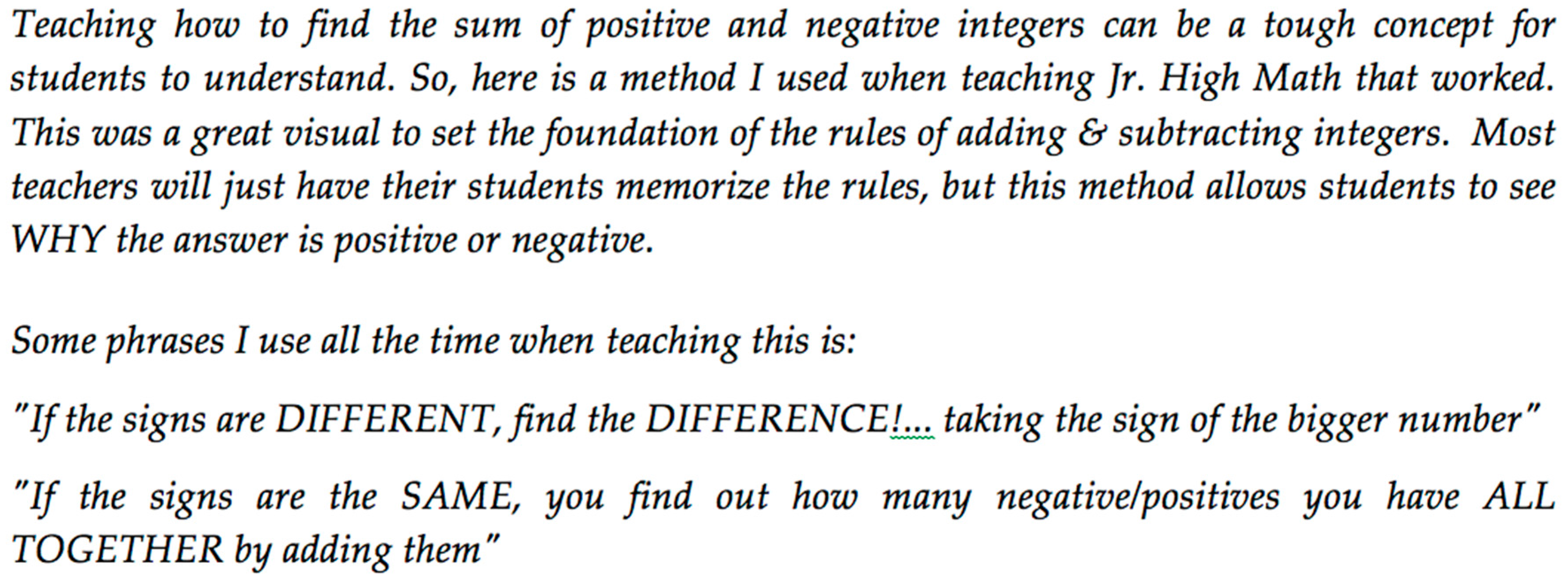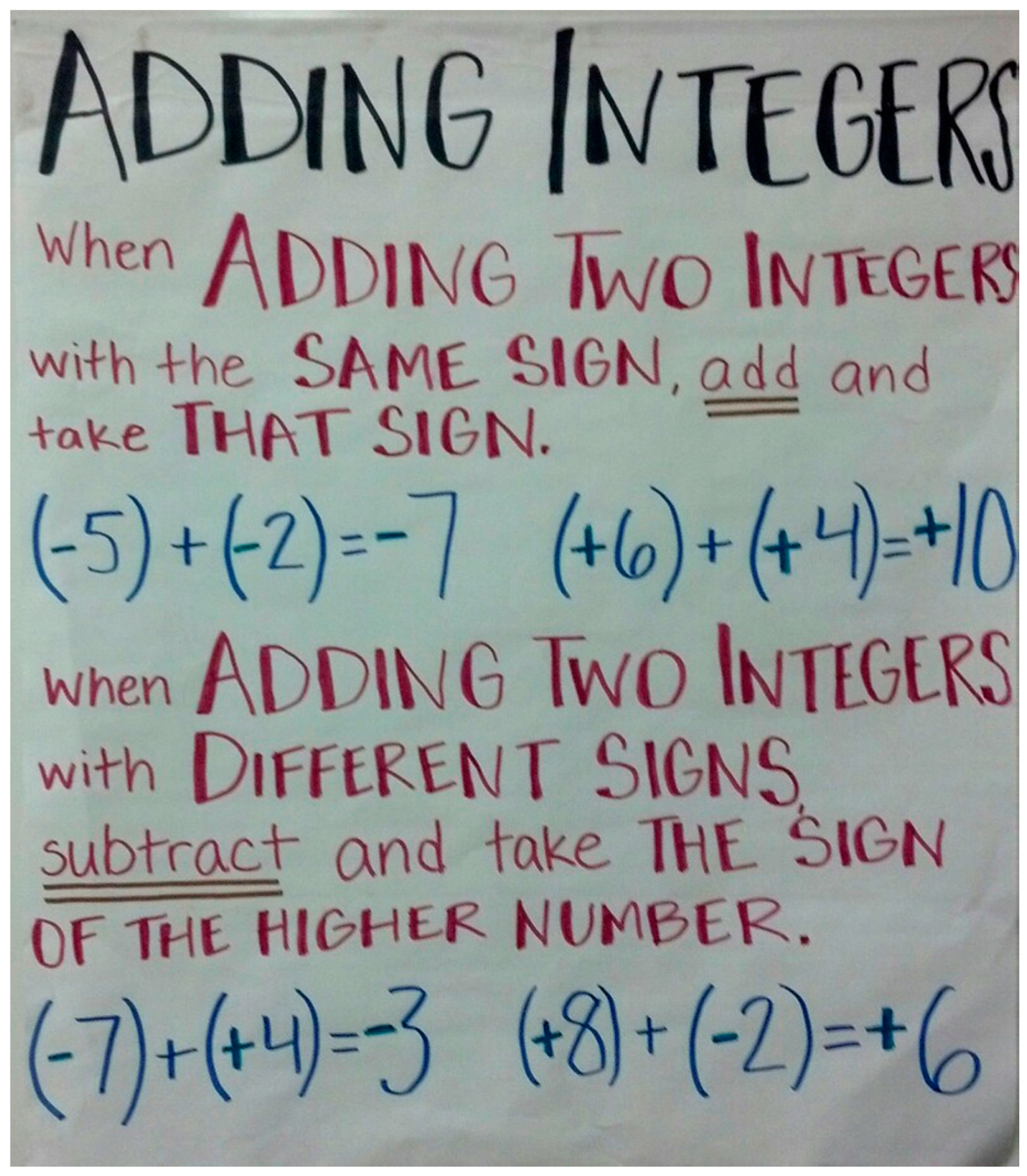Examining Pinterest as a Curriculum Resource for Negative Integers: An Initial Investigation
Abstract
:1. Introduction
Framing Our Work
- What are the characteristics of pins related to negative integers?
- What association, if any, exists between the number of repins and the presence of errors in linked content (e.g., models, language, worked examples)?
2. Materials and Methods
3. Results
3.1. General Characteristics
3.2. Errors within Pin Content
4. Discussion
4.1. Future Directions
4.2. Limitations
5. Final Thoughts
Author Contributions
Conflicts of Interest
References
- Perrin, A. Social Networking Usage: 2005–2015. Pew Research Center, 2015. Available online: http://www.pewinternet.org/2015/10/08/2015/Social-Networking-Usage-2005-2015/ (accessed on 5 January 2017).
- Darleen, O.V.; Kaufman, J.H.; Thompson, L.E. Implementation of K–12 State Standards for Mathematics and English Language Arts and Literacy: Findings from the American Teacher Panel; RAND Corporation: Santa Monica, CA, USA, 2016; Available online: http://www.rand.org/pubs/research_reports/RR1529.html (accessed on 5 January 2017).
- VanOverbeke, D.; Stefanick, P. Pinterest + Research = Preservice teachers’ strategic use of instructional strategies. In Proceedings of the Society for Information Technology & Teacher Education International Conference, Savannah, GA, USA, 21–25 March 2016; Chamblee, G., Langub, L., Eds.; Association for the Advancement of Computing in Education: Chesapeake, VA, USA; pp. 2406–2412. [Google Scholar]
- Carpenter, J.; Abrams, A.; Dunphy, M. Educators’ professional uses of pinterest. In Proceedings of the Society for Information Technology & Teacher Education International Conference, Savannah, GA, USA, 21–25 March 2016; Chamblee, G., Langub, L., Eds.; Association for the Advancement of Computing in Education: Chesapeake, VA, USA; pp. 1925–1930. [Google Scholar]
- Hu, S.; Torphy, K.T. Teachers’ active engagement in social media: Analyzing the quality of mathematical practices within pinterest. In Proceedings of the 38th Annual Meeting of the North American Chapter of the International Group for the Psychology of Mathematics Education, Tucson, AZ, USA, 3–6 November 2016; Wood, M.B., Turner, E.E., Civil, M., Eli, J.A., Eds.; The University of Arizona: Tucson, AZ, USA, 2016; p. 425. [Google Scholar]
- Torphy, K.T.; Hu, S. Teachers’ Active Engagement in social media: Conceptualizing mathematical practices within pinterest. In Proceedings of the 38th Annual Meeting of the North American Chapter of the International Group for the Psychology of Mathematics Education, Tucson, AZ, USA, 3–6 November 2016; Wood, M.B., Turner, E.E., Civil, M., Eli, J.A., Eds.; The University of Arizona: Tucson, AZ, USA, 2016; p. 443. [Google Scholar]
- Siemens, G. Connectivism: A learning theory for the digital age. Int. J. Instr. Technol. Distance Learn. 2005, 2, 3–10. [Google Scholar]
- Heefer, A. Historical objections against the number line. Sci. Educ. 2011, 20, 863–880. [Google Scholar] [CrossRef]
- Piaget, J. To Understand is to Invent: The Future of Education; The Viking Press, Inc.: New York, NY, USA, 1948. [Google Scholar]
- Stephan, M.; Akyuz, D. A proposed instructional theory for integer addition and subtraction. J. Res. Math. Educ. 2012, 43, 428–464. [Google Scholar] [CrossRef]
- Whitacre, I.; Pierson Bishop, J.; Lamb, L.L.; Philipp, R.A.; Bagley, S.; Schappelle, B.P. Negative of my money, positive of her money: Secondary students’ ways of relating equations to a debt context. Int. J. Math. Educ. Sci. Technol. 2015, 46, 1–16. [Google Scholar] [CrossRef]
- Bofferding, L.; Richardson, S.E. Investigating integer addition and subtraction: A task analysis. In Proceedings of the 35th Annual Meeting of the North American Chapter of the International Group for the Psychology of Mathematics Education, Chicago, IL, USA, 14–17 November 2013; Martinez, M., Superfine, A., Eds.; University of Illinois at Chicago: Chicago, IL, USA, 2013; pp. 111–118. [Google Scholar]
- Bofferding, L. Addition and subtraction with negatives: Acknowledging the multiple meanings of the minus sign. In Proceedings of the 32nd Annual Meeting of the North American Chapter of the International Group for the Psychology of Mathematics Education, Columbus, OH, USA, 28–31 October 2010; Brosnan, P., Erchick, D., Flevares, L., Eds.; PME-NA: Columbus, OH, USA, 2010; pp. 703–710. [Google Scholar]
- Bofferding, L.; Wessman-Enzinger, N.M. Subtraction involving negative numbers: Connecting to whole number reasoning. TEM 2017, 14, 241–262. [Google Scholar]
- Bofferding, L.; Hoffman, A. Comparing negative integers: Issues of language. In Proceedings of the 39th Psychology of Mathematics Education Conference, Hobart, Australia, 13–18 July 2015; Beswick, K., Muir, T., Wells, J., Eds.; PME: Hobart, Australia, 2015; Volume 1, p. 150. [Google Scholar]
- Bishop, J.P.; Lamb, L.L.; Philipp, R.A.; Whitacre, I.; Schappelle, B.P.; Lewis, M.L. Obstacles and affordances for integer reasoning: An analysis of children’s thinking and the history of mathematics. J. Res. Math. Educ. 2014, 45, 19–61. [Google Scholar]
- Bishop, J.P.; Lamb, L.L.; Philipp, R.A.; Whitacre, I.; Schapelle, B.P. Leveraging structure: Logical necessity in the context of integer arithmetic. Math. Think. Learn. 2016, 18, 209–232. [Google Scholar] [CrossRef]
- Bofferding, L. Negative integer understanding: Characterizing first graders’ mental models. J. Res. Math. Educ. 2014, 45, 194–245. [Google Scholar]
- Featherstone, H. “-Pat + Pat = 0”: Intellectual play in elementary mathematics. Learn. Math. 2000, 20, 14–23. [Google Scholar]
- Martinez, A.A. Negative Math: How Rules Can Be Positively Bent; Princeton University Press: Princeton, NJ, USA, 2006. [Google Scholar]
- Lakoff, G.; Núñez, R.E. Where Mathematics Comes From: How the Embodied Mind Brings Mathematics into Being; Basic Books: New York, NY, USA, 2000. [Google Scholar]
- Janvier, C. Comparison of models aimed at teaching signed integers. In Proceedings of the 9th Conference of the Psychology of Mathematics Education, Noordwijkerhout, The Netherlands, 22–29 July 1985; Streefland, L., Ed.; International Group for the Psychology of Mathematics Education: Noordwijkerhout, The Netherlands, 1985; Volume 1, pp. 135–140. [Google Scholar]
- Peled, I.; Carraher, D.W. Signed numbers and algebraic thinking. In Algebra in the Early Grades; Kaput, J.J., Carraher, D.W., Blanton, M.L., Eds.; Lawrence Erlbaum Associates: New York, NY, USA, 2008; pp. 303–328. [Google Scholar]
- Schwartz, B.B.; Kohn, A.S.; Resnick, L.B. Positives about negatives: A case study of an intermediate model for signed numbers. J. Learn. Sci. 1993, 3, 37–92. [Google Scholar] [CrossRef]
- English, L.D.; Ärlebäck, J.B.; Mousoulides, N. Reflection on progress in modelling research. In Handbook for Research on the Psychology of Mathematics Education; Gutierrez, A., Leder, G., Boero, P., Eds.; Sense Publishers: Rotterdam, The Netherlands, 2015. [Google Scholar]
- Vig, R.; Murray, E.; Star, J.R. Model breaking points conceptualized. Educ. Psychol. Rev. 2014, 26, 73–90. [Google Scholar] [CrossRef]
- Van den Heuvel-Panhuizen, M. The didactical use of models in realistic mathematics education: An example from a longitudinal trajectory on percentage. Educ. Stud. Math. 2003, 54, 9–35. [Google Scholar] [CrossRef]
- Saxe, G.B.; Diakow, R.; Gearhart, M. Towards curricular coherence in integers and fractions: A study of the efficacy of a lesson sequence that uses the number line as the principle representational context. ZDM Math. Educ. 2013, 45, 343–364. [Google Scholar] [CrossRef]
- Liebeck, P. Scores and forfeits: An intuitive model for integer arithmetic. Educ. Stud. Math. 1990, 21, 221–239. [Google Scholar] [CrossRef]
- Whitacre, I.; Bishop, J.P.; Lamb, L.L.C.; Philipp, R.A.; Schappelle, B.P.; Lewis, M. Integers: History, textbook approaches, and children’s productive mathematical intuitions. In Proceedings of the 33rd Annual Meeting of the North American Chapter of the International Group for the Psychology of Mathematics Education, Reno, NV, USA, 20–23 October 2011; Wiest, L.R., Lamberg, T., Eds.; University of Nevada, Reno: Reno, NV, USA, 2011; pp. 913–920. [Google Scholar]
- Wessman-Enzinger, N.M.; Salem, W. An illustration of scholarly inquiry from the cognitive perspective: The development of an integer activity for prospective elementary or middle school teachers. In Building Support for Scholarly Practices in Mathematics Methods; The Association of Mathematics Teacher Educators Professional Series; Information Age Publishing: Charlotte, NC, USA, in press.
- Lappan, G.; Fey, J.T.; Fitzgerald, W.M.; Friel, S.N.; Phillips, E.D. Connected Mathematics 2: Accentuate the Negative; Prentice Hall: Boston, MA, USA, 2006. [Google Scholar]
- Wessman-Enzinger, N.M.; Salem, W. An illustration of scholarly inquiry from the cognitive perspective: The development of an integer activity for prospective elementary or middle school teachers. In Building Support for Scholarly Practices in Mathematics Methods; Information Age Publishing: Charlotte, NC, USA, in press.
- Schreier, M. Qualitative Content Analysis. In The SAGE Handbook of Qualitative Data Analysis; Flick, U., Ed.; SAGE Publications Ltd.: Thousand Oaks, CA, USA, 2014; pp. 170–183. [Google Scholar]
- Mayring, P. Qualitative Content Analysis. Forum Qualitative Sozialforschung / Forum: Qualitative Social Research 2000, 1, 20. Available online: http://nbn-resolving.de/urn:nbn:de:0114-fqs0002204 (accessed on 30 March 2017).
- Wessman-Enzinger, N.M. Developing and describing the use and learning of conceptual models for integer addition and subtraction of Grade 5 students. Doctoral dissertation, Illinois State University, Normal, IL, USA, 2015. [Google Scholar]




| Keywords | Number of Pins Identified |
|---|---|
| negative integer | 126 (66%) |
| integers negative | 36 (19%) |
| negative integer activities | 14 (7%) |
| Characteristics of Pin | Percent |
|---|---|
| Includes negative integers | 77% |
| Operations | |
| Addition | 82% |
| Subtraction | 70% |
| Multiplication | 29% |
| Division | 27% |
| Includes a model | 55% |
| References game | 32% |
| Includes links to paysites | 22% |
| Use of real-world context | 15% |
© 2017 by the authors. Licensee MDPI, Basel, Switzerland. This article is an open access article distributed under the terms and conditions of the Creative Commons Attribution (CC BY) license (http://creativecommons.org/licenses/by/4.0/).
Share and Cite
Hertel, J.T.; Wessman-Enzinger, N.M. Examining Pinterest as a Curriculum Resource for Negative Integers: An Initial Investigation. Educ. Sci. 2017, 7, 45. https://doi.org/10.3390/educsci7020045
Hertel JT, Wessman-Enzinger NM. Examining Pinterest as a Curriculum Resource for Negative Integers: An Initial Investigation. Education Sciences. 2017; 7(2):45. https://doi.org/10.3390/educsci7020045
Chicago/Turabian StyleHertel, Joshua T., and Nicole M. Wessman-Enzinger. 2017. "Examining Pinterest as a Curriculum Resource for Negative Integers: An Initial Investigation" Education Sciences 7, no. 2: 45. https://doi.org/10.3390/educsci7020045
APA StyleHertel, J. T., & Wessman-Enzinger, N. M. (2017). Examining Pinterest as a Curriculum Resource for Negative Integers: An Initial Investigation. Education Sciences, 7(2), 45. https://doi.org/10.3390/educsci7020045





